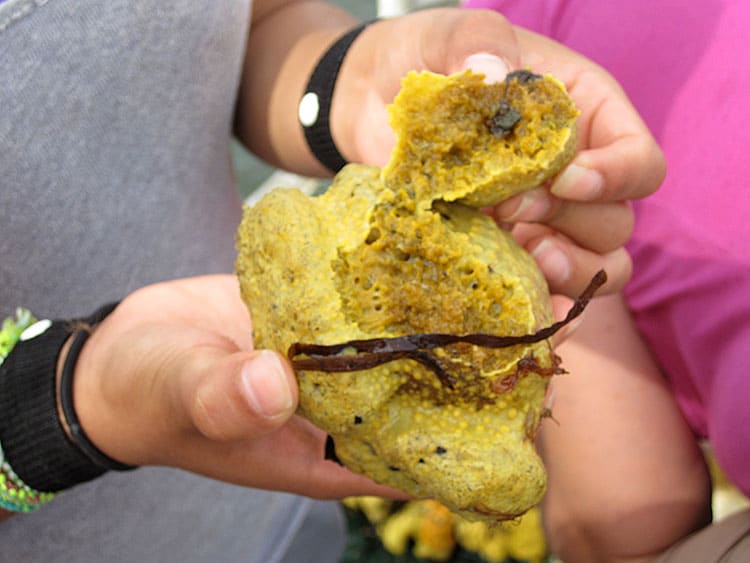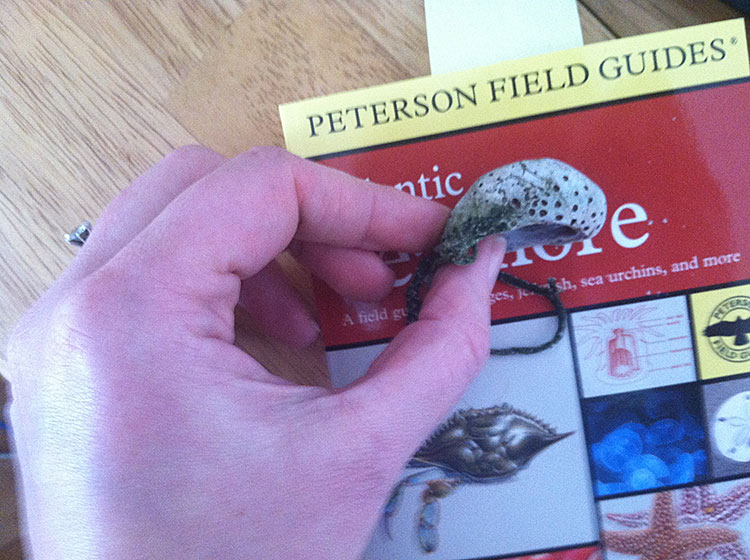• by Dr. Sarah D. Oktay, Managing Director UMass Boston Nantucket Field Station •
We pulled up a common resident of our harbors the other day while doing a dredge for our Marine Ecology class off Pocomo Point. Scattered amongst the spider crabs and scallops and loose eelgrass and algae was the omnipresent boring sponge. The large gloppy yellowish blobs are called monkey dunk by scallopers who dredge them up in the winter. What we pulled up has also transformed many of the shells you will find on the beach. Next time you are walking at the beach look for shells with dozens of small almost perfectly round holes in them. Those were made by a boring sponge named for its penetrating skills (not monotonous conversation) that uses acid to dissolve the calcium based shell of its host. The only function of the shell or stone is a place to live for the sponge. The shellfish living in the drilled shell is not consumed, but usually dies since its protective covering has been damaged. Thank goodness bivalves don’t have higher cognitive functions because I think it would be pretty scary to know something is slowly eating its way through your home.

I found an excellent online summary of sponges by Michelle Kelley and Franz Smith (found at http://www.treasuresofthesea.org.nz/sponges retrieved August 5th, 2013) that clearly explains more about this amazing group of organism: “Sponges are among the oldest living multicellular organisms, with a fossil record dating back to about 600 million years. They are often considered to be the most primitive of animal groups, largely due to their apparently simple body structure that lacks actual tissues or organs, yet they represent a highly specialized and successful group of benthic suspension-feeders in marine and fresh waters. Indeed, so adaptable are sponges that a small group in the deepest ocean has successfully switched to a carnivorous lifestyle. Their persistence throughout geological time, wide global distribution, and occurrence in diverse habitat types are evidence of their adaptability.”
The sponge phylum, Porifera which means “the pore bearers”, is divided into three distinct classes. The Calcarea have spicules (tiny spike-like structures) of calcium carbonate in the calcite form and are commonly known as “calcareous” sponges. The Demospongiae, which is the most diverse class of sponges, have skeletons of two components, a mineral skeleton of silica (glass) spicules, and an organic skeleton made of diverse forms of spongin (collagen) fiber. Some sponges lack spicules, some lack fiber, and some combine the two. Some even incorporate sand into their skeleton. Some demosponges, called the “sclerosponges”, form a stony base of calcium carbonate in the aragonite form, with a veneer of living “tissue” on the surface. These sponges also produce silica spicules. Lastly are the Hexactinellida, commonly known as the glass sponges, which have siliceous spicules with a hexactine (six-ray) design.
According to the real UMass Boston Nantucket Field Station marine biologist (unlike me), Dr. Beth Boyle who teaches the advanced level (306/506) of Marine and Coastal Ecological Research here at the field station each summer and is an expert on invertebrate species, the species name of the huge pile of yellow sponges we found (several pounds) is most likely Cliona celata. She mentions that to positively identify a sponge you would normally do a spicule analysis under a microscope to confirm that you have the right species. Cliona celata is a cosmopolitan species which means it is well traveled for a sessile marine species and it can be found anywhere in the world with an appropriate habitat (reminds me of a “Sex in the City” character). It starts out boring into shells or even limestone and can eventually overgrow its host and reach the state we saw it on the boat where the host was no longer visible. Many of the sponges we broke open only had a few sand particles inside them. Sponges feed by pumping water through their pores. Most sponges work rather like chimneys: they take in water at the bottom and eject it from the osculum (“little mouth”) at the top. Since ambient currents are faster at the top, the suction effect that they produce does some of the work for free. Sponges can control the water flow by various combinations of wholly or partially closing the osculum and ostia (the intake pores) and varying the beat of the flagella, and may shut it down if there is a lot of sand or silt in the water.
Cliona belongs to the class Demospongiae mentioned above which has the most representatives in the phylum Porifera. The demosponges include 90% of all species of sponges and are predominantly leuconoid in structure. There are many diverse orders in this Demospongiae, including all of the large sponges. Most are marine dwellers, but several live in freshwater environments. Some species are brightly colored, and there is great variety in body shape; the largest species are over 1 meter (3.3 ft) across. They reproduce both sexually and asexually (more about that below).
Out local monkey dunk even has the ability to bore through solid rock, like the others in the genus Cliona. C. celata can be up to 100 cm across and 50 cm high, but are usually smaller. They have a coloration of different shades of yellow, but in some cases, red coloration around the openings. They can adapt to many environments by changing the way their cells are distributed across the substrate. These forms are ridged, burrowing, massive, massive/chimneys, encrusting, or encrusting/chimneys. It is usually pretty easy to recognize C. celata because of its color and sieve-like openings. Cliona celata is called the “red boring sponge” because of a slight reddish tint around the holes. This sponge creates round holes up to 5 cm in diameter in limestone or the shells of mollusks, especially oysters. The sponge itself is often visible as a rather featureless yellow or orange lump at the bottom of the hole. They seem to really like large quahogs here and you will often find densely bored quahog shells on our beaches. The whole sponge shows a noticeable decrease in size when removed from the water. The consistency of this sponge is firm and inflexible with a tough outer layer that often feels almost fake or plastic-ish.

In the world porifera database (yep a big database of sponges) we find out how C. celata got its name. The sponge was first described by R.E. Grant in 1826 in an article called “Notice of a New Zoophyte (Cliona celata Gr.) from the Firth of Forth”. Edinburgh New Philosophical Journal 1: 78-81. Love that location name, the “firth of Forth” (found at http://www.marinespecies.eu/porifera/porifera.php?p=taxdetails&id=193632&from=rss).
Now for our weekly etymology breakdown: “celatus” is Latin for “concealed or hidden”, referring to the boring habit, and Cliona is from the New Latin for the Clio, the Muse. She is known as the Muse of History and is often shown carrying parchments or scrolls and is sometimes known as the Proclaimer. From a pile of yellow gunk on your deck to the muse of poets and historians, now you see why I like etymology.
According to the Marine Species Identification Portal (http://species-identification.org/species.php?species_group=sponges&id=184) Cliona celata Grant (1826) is a yellow excavating (or boring) sponge, occurring in two distinct forms. One is the boring form, recognizable as yellow papillae sticking out of limestone (calcareous rocks, shells, etc.); the other is a large massive, wall-shaped sponge covered with characteristic flattened papillae. This species is the only excavating sponge in NW Europe developing the massive form; other species of Cliona only occur in the boring form. It is also the only Cliona without microscleres (microscopic examination necessary). The boring form is very common in oyster and mussel beds, where they cause some damage to shell fish farming. The massive form develops when the sponge has outgrown its habitat, or when it has completely filled crevices in calcareous rocks into which it cannot bore. Some of the boring sponges favorite victims include: Crassostrea virginica (eastern oysters), Crepidula fornicata (Slipper limpets) and Mercenaria mercenaria (quahog or hard clam). It may be confused with the similarly colored C. lobata, but that species has much smaller and more numerous papillae, and it has microscleres. Sometimes C. celata is also confused for or listed in earlier works as Cliona sulphurea (Disor), which was found in an early 20th century Maria Mitchell Publication.
There are some other species of Cliona found near coral reefs that are indicators of excessive organic pollution but this species can be abundant in perfectly pristine waters. Some of the reasons that monkey dunk aka this boring sponge is common around Nantucket include: plenty of shells for them to colonize; decent water circulation in the harbor to extract food from (suspension feeders); and a lack of predators. Not many things eat sponges, there main “foes” are nudibranchs, small crabs, and small crustaceans, but they can regenerate cells lost to small amounts of predation (minor “flesh wounds”). Red Boring Sponges can reproduce asexually and sexually. They can simply separate by mitosis, as single cells do, or they can release sperm into the water in hopes of them finding a female’s eggs. They may also attach their larvae onto mollusks like clams and mussels. This usually results in the death of the host. They then will begin to grow and colonize.
The effects of climate change are being studied for a multitude of invertebrates including the many species or bivalves we eat. During on island lectures I usually introduce research by J.M. Guinotte and V.J. Fabry from 2008 that show that the effects from these environmental changes will vary among taxonomic groups, with calcifying organisms like corals and mollusks considered to be most at risk of adverse impacts like shell loss, body weight reductions or even inability to stay alive. I was able to find an even more recent paper by Alan R. Duckworth and Bradley J. Peterson entitled “Effects of seawater temperature and pH on the boring rates of the sponge Cliona celata in scallop shells” published in the September 14 2012 issue of Marine Biology (accessed August 5th at http://blueocean.org/documents/2012/10/marine-sponges-bore-into-shellfish-faster-due-to-effects-of-climate-change.pdf). These scientists’ mimicked conditions that are likely to occur in coastal waters in the next fifty years as the oceans waters warm up and become more acidic from increased levels of carbon dioxide in the atmosphere. The warmer temperatures didn’t do much to the boring sponges, but the lower pH (7.8 versus 8.1) water made a huge difference. The sponge’s rate of bioerosion (how it drills into the shell) doubled in the more acidic and warmer conditions resulting in scallop shells that were significantly weaker and twice as thin as normal which exposes them to greater predation. Sometimes it is hard to see on a local and fishery level what climate change can do, but this is certainly a sobering thought. I measure pH frequently in the harbor and it often around 7.8 pH which matches the experimental pH. One possible saving grace is that the scientists also found that the sponge was taking longer to attach to shells at the lower pH and slightly warmer conditions. Sponges attach to a substrate using a collagenous matrix made of spongin and fibronectin (both good scrabble words) that is secreted by cells on the base of the sponge called basopinacocytes. The authors theorized that the low pH might interfere with this secretion process.
Hope you enjoyed this article and will check out some shells and monkey dunk on your next swim or walk on the beach.
More information at Guinotte JM, Fabry VJ (2008) Ocean acidification and its potential effects on marine ecosystems. Ann N Y Acad Sci 1134:320–342


